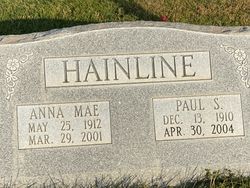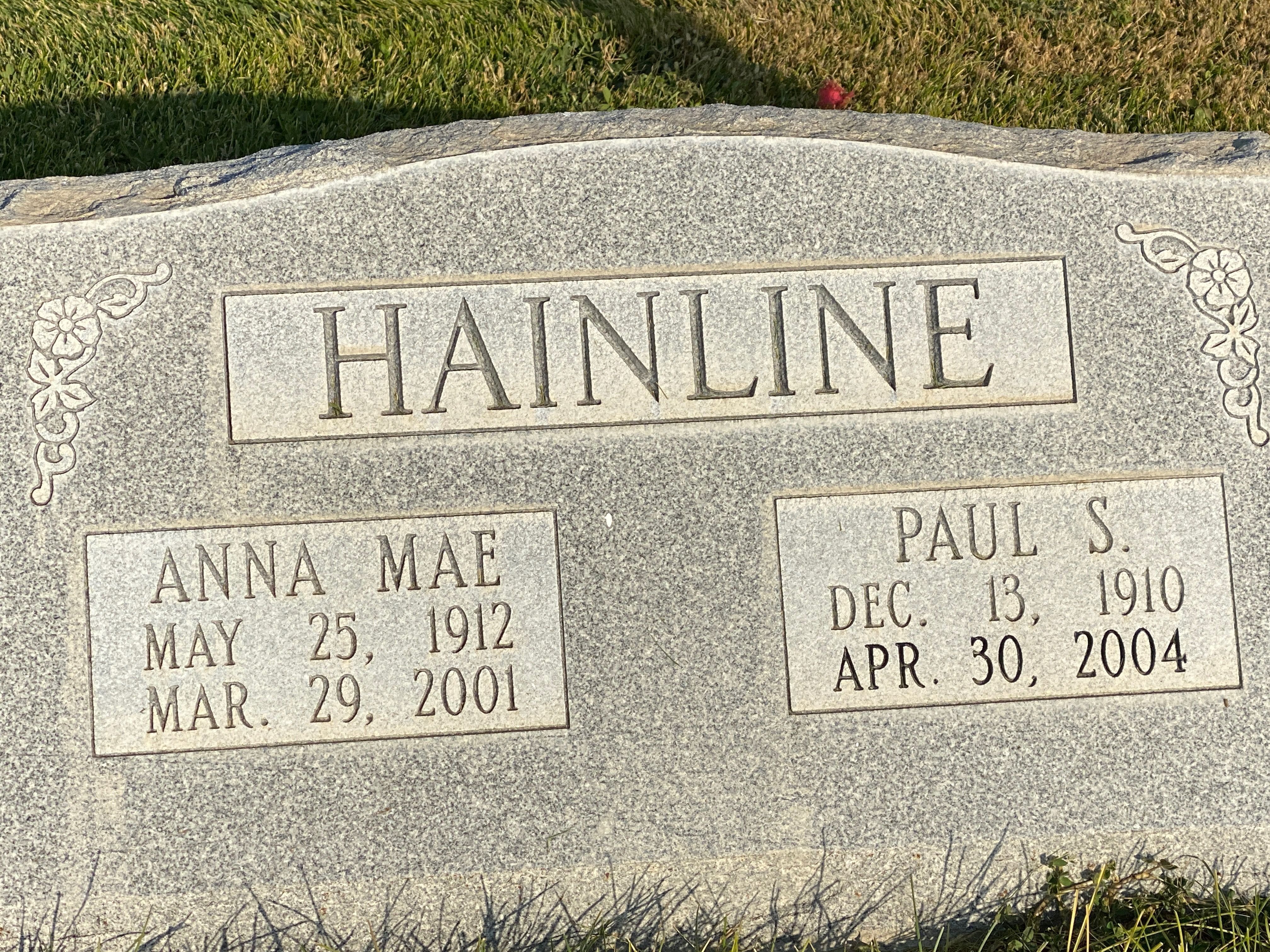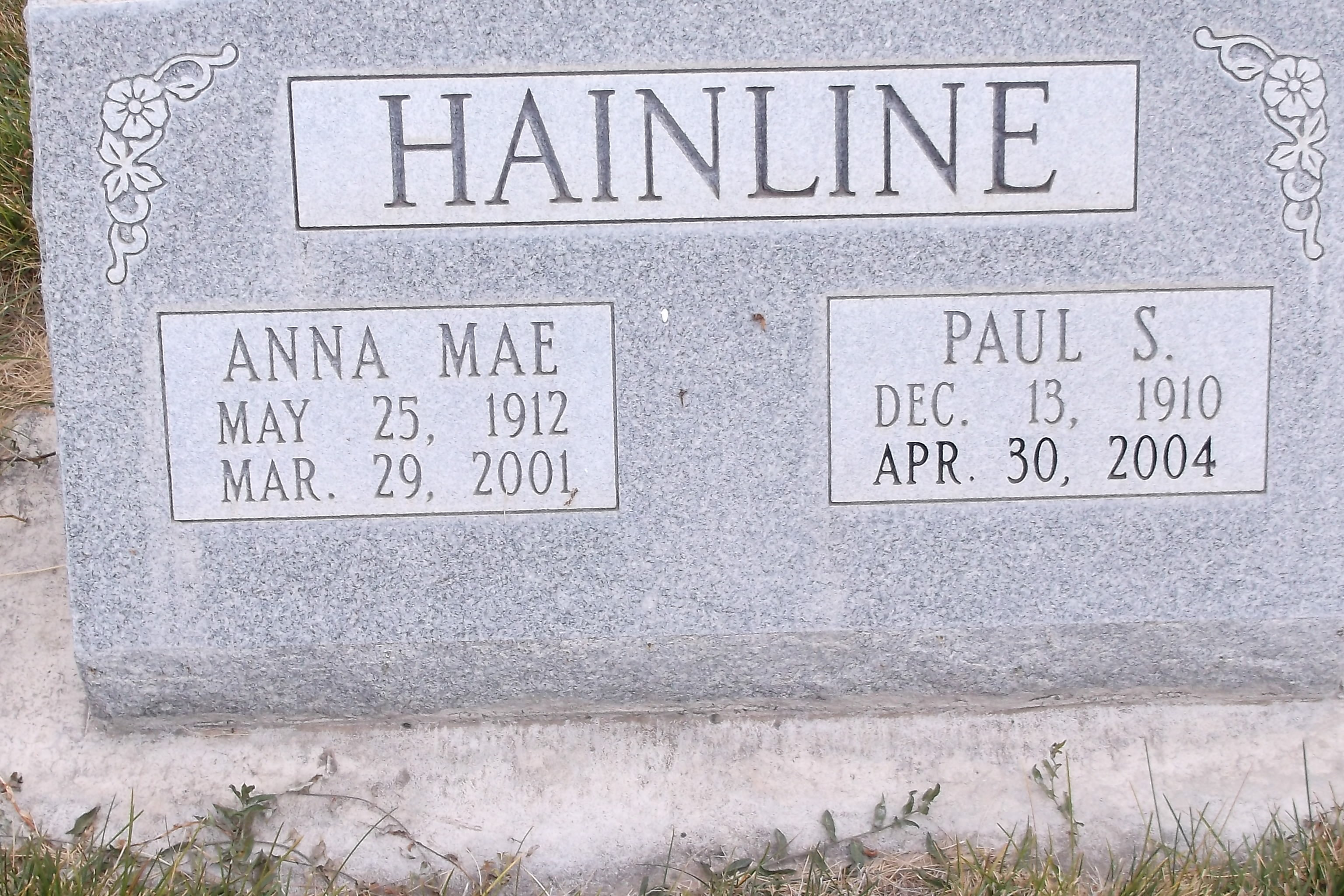Paul Scott Hainline, 93, of Twin Falls, passed away on Friday, April 30, 2004, at Magic Valley Regional Medical Center in Twin Falls, Idaho.
Paul, the third child of Jesse and Irene (Weddle) Hainline, was born Dec. 13, 1910, on a farm in Macon County, Ill., one and one-fourth miles west of Cisco. In 1916, Paul moved with his family to the Pattengill Farm and began attending school. On the Pattengill Farm, Paul and his brother Harold hunted rabbits, possums and raccoons. They swam and fished in the Sangamon River which bordered the farm. Paul learned to work on that farm, turning the cream separator for his parents, feeding the hogs and working in his mother's vegetable garden. In 1920, Paul moved by train with his family to Filer, Idaho. They all became ill with the flu on the move, and so it was awhile before Paul could get back to his education. He returned to school at the age of 10 and attended Filer Central School. After school and on weekends, Paul delivered milk for Hainline's Dairy, which was called Filer Dairy. When Paul turned 17 in 1927, his parents gave up the dairy. He attended Filer Rural High School in 1927-1929, but did not complete graduation. He played football, basketball and baseball in high school. During this time, Paul worked for Fred Munyon on his farm on the Huddleston Road. He also worked on a WPA project putting in a sewer system in Filer. He was on the pick and shovel crew loading dirt wagons and hauling them away. After his last year of high school, Paul started work on the Friedman Farm and then went to the Amalgamated Sugar Company beet dumps in the fall. From 1930-1940, Paul along with his family suffered through the Depression. He tried his hand at farming, raising hay, grain, beets, potatoes and peas. Also he tended broods of hogs and flocks of sheep. He tried to make a living but due to hard times and problems, he was forced to return home and live with his parents.
In 1938, Paul joined the National Guard Ordinance Unit in Jerome and, in 1941, he enlisted in the United States Army. Due to a glitch in the paperwork, his discharge papers being lost and Pearl Harbor being bombed, Paul was required to stay on active duty until 1946. He spent World War II in Iran. Paul's unit was shuffled around to several army bases to be trained and ended up in Oakland. From there, they went by train to New Jersey to guard a large ammunition factory for a while. Next they went to a base in Pennsylvania, to the Aberdeen Proving Grounds, and then to Camp Kilmer in New Jersey. While at Aberdeen, Paul was made sergeant and put in charge of his unit. He attended an intelligence school in the Smithsonian Institute in Washington D.C., probably while his unit was at Camp Kilmer. Finally, they were ordered to proceed to Staten Island to board a troop ship, destination unknown. The ship took them through the Panama Canal to Perth, Australia, where they stayed a while, then on to Bombay, India. They thought they were going to have to stay in India, but soon moved on and were surprised to end up in Iran after spending a total of 67 days on the ship and going half way around the world. Paul's unit spent two years at an Allis Chalmers factory in Iran, supervising the building of 55,000 trucks and other vehicles that were sent to Russia to be used in fighting the Germans. The workers they supervised were from various Middle Eastern countries. In addition to working in the factory, Paul spent part of his time doing intelligence work in various parts of Iran. When they were finished in Iran, Paul's unit went on a troop ship through the Suez Canal, and down the Mediterranean to Algiers. After a while, they crossed over to southern France, where the Allies had established a beachhead and were driving the Germans north through Europe. For the next two years, they were involved in the campaign in France, Belgium and Germany, usually not on the front lines. They often went into liberated towns to help restore water and sewage systems, and build medical facilities to care for the injured or diseased. Paul, another non-conformist and a civilian interpreter once ventured out ahead of the troops and found an underground factory where V-bombs were being made to bomb England. This discovery greatly excited allied intelligence people. Another time, Paul and the interpreter got lost, ended up with Russian soldiers in Czechoslovakia, and spent the night in a drinking party with the Russians. Finally, his unit went back to southern France, boarded a rusty old victory ship, and headed home. En route they passed through a hurricane and thought they were going to perish after surviving the war. They landed at Staten Island, disembarking on the pier next to the troop ship that carried them overseas five years before. When he was discharged in September 1946, it was the end of what was supposed to be just a 13 month enlistment.
Before Paul arrived home, the Amalgamated Sugar Company told Jesse, who was their agricultural superintendent by then, that they wanted Paul to come to work as their field man in the Filer-Buhl-Castleford territory. When he arrived in Twin Falls, they wanted him to come to work that same day, but he declined so he could have the rest of the day to buy some civilian clothes. He started the next day, and worked as field man for the company until he retired 30 years later.
On Sept. 25, 1946, Paul married the love of his life, Anna Mae Diehl in Pocatello, Idaho. They had been classmates in high school but had not dated. Anna Mae left after graduation and moved to California, where she became a designer for the motion picture industry in Los Angeles. Thinking to do her patriotic duty, she asked a friend for Paul's address and corresponded with him all through the war. Paul and Anna Mae had no children, but when Paul retired in 1976 they sold their home in Filer and moved to Twin Falls. They also purchased a mobile home in Boulder City near Las Vegas, Nev., and spent their winters there. They had friends in Boulder City, loved to play cards and socialize. Paul also liked golfing, camping and to fish in Lake Mead, where he caught yellow catfish and striped bass.
On March 29, 2001, Anna Mae passed away at the age of 89. Paul remained in the apartment on North Rose Street, and he was vital and active until the end.
Surviving Paul are his brothers, Charles of Logan, Utah, and Rex of Sprague, Wash.; nephews, Ralph Smith of Filer and Fred Hainline of Bliss, Idaho, as well as a host of nieces, nephews and extended family.
A memorial service will be held at 11 a.m. Thursday, May 6, 2004, at the United Methodist Church in Filer, Idaho, with Pastor Sandra Kimbrow officiating. Inurnment will follow at the Filer Cemetery. Arrangements are under the direction of Parke's Magic Valley Funeral Home in Twin Falls.
In lieu of flowers, the family requests that memorials be sent to the Primary Children's Hospital Foundation, P.O. Box 58249, Salt Lake City, UT 54158-0249.
? Published Sunday, May 2, 2004
Paul Scott Hainline, 93, of Twin Falls, passed away on Friday, April 30, 2004, at Magic Valley Regional Medical Center in Twin Falls, Idaho.
Paul, the third child of Jesse and Irene (Weddle) Hainline, was born Dec. 13, 1910, on a farm in Macon County, Ill., one and one-fourth miles west of Cisco. In 1916, Paul moved with his family to the Pattengill Farm and began attending school. On the Pattengill Farm, Paul and his brother Harold hunted rabbits, possums and raccoons. They swam and fished in the Sangamon River which bordered the farm. Paul learned to work on that farm, turning the cream separator for his parents, feeding the hogs and working in his mother's vegetable garden. In 1920, Paul moved by train with his family to Filer, Idaho. They all became ill with the flu on the move, and so it was awhile before Paul could get back to his education. He returned to school at the age of 10 and attended Filer Central School. After school and on weekends, Paul delivered milk for Hainline's Dairy, which was called Filer Dairy. When Paul turned 17 in 1927, his parents gave up the dairy. He attended Filer Rural High School in 1927-1929, but did not complete graduation. He played football, basketball and baseball in high school. During this time, Paul worked for Fred Munyon on his farm on the Huddleston Road. He also worked on a WPA project putting in a sewer system in Filer. He was on the pick and shovel crew loading dirt wagons and hauling them away. After his last year of high school, Paul started work on the Friedman Farm and then went to the Amalgamated Sugar Company beet dumps in the fall. From 1930-1940, Paul along with his family suffered through the Depression. He tried his hand at farming, raising hay, grain, beets, potatoes and peas. Also he tended broods of hogs and flocks of sheep. He tried to make a living but due to hard times and problems, he was forced to return home and live with his parents.
In 1938, Paul joined the National Guard Ordinance Unit in Jerome and, in 1941, he enlisted in the United States Army. Due to a glitch in the paperwork, his discharge papers being lost and Pearl Harbor being bombed, Paul was required to stay on active duty until 1946. He spent World War II in Iran. Paul's unit was shuffled around to several army bases to be trained and ended up in Oakland. From there, they went by train to New Jersey to guard a large ammunition factory for a while. Next they went to a base in Pennsylvania, to the Aberdeen Proving Grounds, and then to Camp Kilmer in New Jersey. While at Aberdeen, Paul was made sergeant and put in charge of his unit. He attended an intelligence school in the Smithsonian Institute in Washington D.C., probably while his unit was at Camp Kilmer. Finally, they were ordered to proceed to Staten Island to board a troop ship, destination unknown. The ship took them through the Panama Canal to Perth, Australia, where they stayed a while, then on to Bombay, India. They thought they were going to have to stay in India, but soon moved on and were surprised to end up in Iran after spending a total of 67 days on the ship and going half way around the world. Paul's unit spent two years at an Allis Chalmers factory in Iran, supervising the building of 55,000 trucks and other vehicles that were sent to Russia to be used in fighting the Germans. The workers they supervised were from various Middle Eastern countries. In addition to working in the factory, Paul spent part of his time doing intelligence work in various parts of Iran. When they were finished in Iran, Paul's unit went on a troop ship through the Suez Canal, and down the Mediterranean to Algiers. After a while, they crossed over to southern France, where the Allies had established a beachhead and were driving the Germans north through Europe. For the next two years, they were involved in the campaign in France, Belgium and Germany, usually not on the front lines. They often went into liberated towns to help restore water and sewage systems, and build medical facilities to care for the injured or diseased. Paul, another non-conformist and a civilian interpreter once ventured out ahead of the troops and found an underground factory where V-bombs were being made to bomb England. This discovery greatly excited allied intelligence people. Another time, Paul and the interpreter got lost, ended up with Russian soldiers in Czechoslovakia, and spent the night in a drinking party with the Russians. Finally, his unit went back to southern France, boarded a rusty old victory ship, and headed home. En route they passed through a hurricane and thought they were going to perish after surviving the war. They landed at Staten Island, disembarking on the pier next to the troop ship that carried them overseas five years before. When he was discharged in September 1946, it was the end of what was supposed to be just a 13 month enlistment.
Before Paul arrived home, the Amalgamated Sugar Company told Jesse, who was their agricultural superintendent by then, that they wanted Paul to come to work as their field man in the Filer-Buhl-Castleford territory. When he arrived in Twin Falls, they wanted him to come to work that same day, but he declined so he could have the rest of the day to buy some civilian clothes. He started the next day, and worked as field man for the company until he retired 30 years later.
On Sept. 25, 1946, Paul married the love of his life, Anna Mae Diehl in Pocatello, Idaho. They had been classmates in high school but had not dated. Anna Mae left after graduation and moved to California, where she became a designer for the motion picture industry in Los Angeles. Thinking to do her patriotic duty, she asked a friend for Paul's address and corresponded with him all through the war. Paul and Anna Mae had no children, but when Paul retired in 1976 they sold their home in Filer and moved to Twin Falls. They also purchased a mobile home in Boulder City near Las Vegas, Nev., and spent their winters there. They had friends in Boulder City, loved to play cards and socialize. Paul also liked golfing, camping and to fish in Lake Mead, where he caught yellow catfish and striped bass.
On March 29, 2001, Anna Mae passed away at the age of 89. Paul remained in the apartment on North Rose Street, and he was vital and active until the end.
Surviving Paul are his brothers, Charles of Logan, Utah, and Rex of Sprague, Wash.; nephews, Ralph Smith of Filer and Fred Hainline of Bliss, Idaho, as well as a host of nieces, nephews and extended family.
A memorial service will be held at 11 a.m. Thursday, May 6, 2004, at the United Methodist Church in Filer, Idaho, with Pastor Sandra Kimbrow officiating. Inurnment will follow at the Filer Cemetery. Arrangements are under the direction of Parke's Magic Valley Funeral Home in Twin Falls.
In lieu of flowers, the family requests that memorials be sent to the Primary Children's Hospital Foundation, P.O. Box 58249, Salt Lake City, UT 54158-0249.
? Published Sunday, May 2, 2004
Family Members
Sponsored by Ancestry
Advertisement
Explore more
Sponsored by Ancestry
Advertisement




